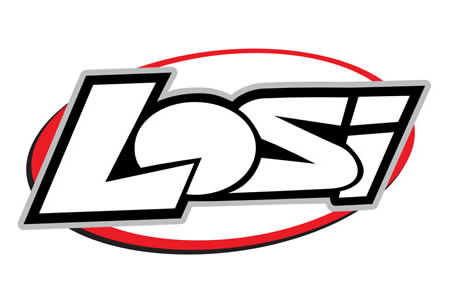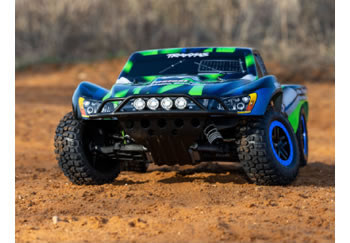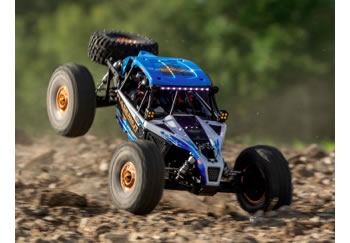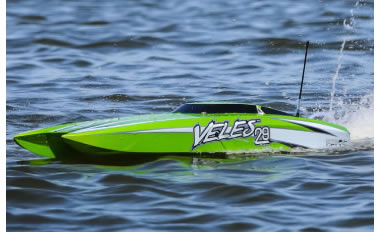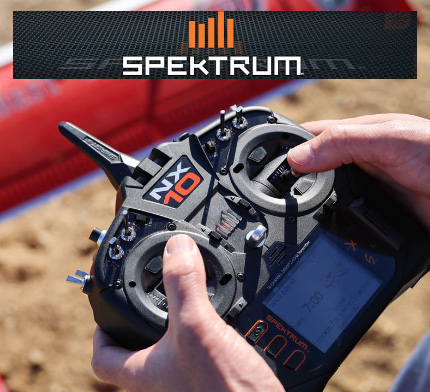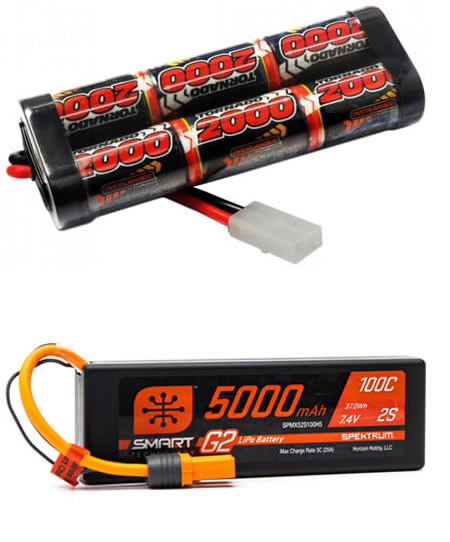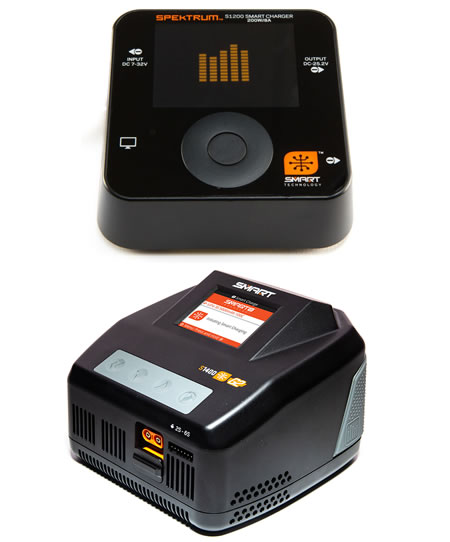Eduard 1/48 Kamikaze A6M5/A6M2-K Dual Combo Limited Edition # 11184
KAMIKAZE TOKKOTAI DUAL COMBO
Premiere of the new model kits:
Mitsubishi A6M5 Zero Model 52 and the two-seat trainer Zero A6M2-K both in 1/48 scale!
A6M5 Zero Type 52, probably c/n 4271, Lt. Yukio Seki, 1st Kamikaze Tokubetsu K?gekitai, Shikishima-tai, Mabalacat airfield, Phillipines, October 1944
A6M5 Zero Type 52, Hik?tai 165, K?k?tai 653, IJN Zuih?, ?ita base, Japan, September 1944
A6M5 Zero Type 52, K?k?tai 210, Meiji Base, Japan, winter 1944-1945
A6M5 Zero Type 52, Lt. (jg) Seiz? Yasunori, Kamikaze Tokubetsu K?gekitai, Dai 7 Sh?wa-tai, Kanoya Base, Japan, May 1945
A6M5 Zero Type 52, Lt. Nao Sugisaki, K?k?tai 352, ?mura Base, Japan, March 1945
A6M2-K, Ensign K?z? Koizumi, Kamikaze Tokubetsu K?gekitai, Dai 7 Sh?wa-tai, Kanoya Base, Japan, April 1945
A6M2-K, Kasumigaura K?k?tai, Sent?ki Tokubetsu K?gekitai, Chitose Base, Japan, July 1945
A6M2-K, Lt. (jg) Tamotsu Kaneko, Kamikaze Tokubetsu K?gekitai, Dai 1 Tsukuba-tai, Kanoya Base, Japan, April 1945
A6M2-K, Tsukuba K?k?tai, Tsukuba Base, Japan, 1944
A6M2-K, Tsukuba K?k?tai, Tsukuba Base, Japan, 1944
 Spread the cost with Paypal Credit
0% for 24 months available on orders over £199
Spread the cost with Paypal Credit
0% for 24 months available on orders over £199
 Spread the cost with Klarna
0% for 24 months available on orders over £199
Spread the cost with Klarna
0% for 24 months available on orders over £199
![]()
The Mitsubishi A6M5 Zero and its variant, the A6M2-K, were Japanese aircraft often used in kamikaze (suicide attack) missions towards the later stages of World War II.
As the tide of war turned against Japan, the Imperial Japanese Navy (IJN) increasingly relied on kamikaze tactics, using these aircraft to deliver devastating attacks on Allied naval vessels.
A6M5 Zero (Kamikaze Version):
The Mitsubishi A6M5 Zero was an upgraded version of the iconic A6M Zero, a highly maneuverable and fast fighter that dominated the early years of the Pacific War.
The A6M5 was adapted for kamikaze missions as Japan faced mounting losses and dwindling resources.
Design and Modifications:
Airframe: Similar to earlier Zero models but reinforced for durability. However, by the time the A6M5 was used in kamikaze missions, it was often stripped of unnecessary equipment to make room for explosives.
Engine: Powered by the Nakajima Sakae 21 radial engine, producing 1,130 horsepower, giving the aircraft a top speed of about 351 mph (565 km/h).
Payload: Typically loaded with a 250 kg (550 lb) bomb or larger explosive payload, carried under the fuselage to maximize the destructive impact upon crashing into enemy vessels.
Role in Kamikaze Missions:
Attack Profile: Kamikaze pilots flew the A6M5 in steep dives to maximize the speed and kinetic impact of their attacks on Allied ships.
Target: Primary targets were aircraft carriers and large warships, with the intent of inflicting catastrophic damage.
Effectiveness: Despite the aircraft's vulnerability to anti-aircraft fire and intercepting Allied fighters, kamikaze attacks inflicted significant damage on the U.S. Navy in the Pacific, particularly during the Battle of Leyte Gulf and the Battle of Okinawa.
A6M2-K (Two-Seat Kamikaze Trainer):
The Mitsubishi A6M2-K was a two-seat training version of the original A6M2 Zero, modified for pilot training purposes. However, as Japan’s situation became desperate, even these training aircraft were repurposed for kamikaze missions.
Design and Modifications:
Airframe: Similar to the A6M2 but with an extended fuselage to accommodate a second seat for the instructor.
Engine: The A6M2-K used the Nakajima Sakae 12 engine, producing around 950 horsepower.
Payload: Similar to the A6M5, these trainers were often retrofitted with explosive payloads when used in kamikaze attacks.
Dual Seat Configuration: While originally designed for pilot training, during kamikaze operations, the second seat was sometimes used to carry an instructor or co-pilot, but it was often left empty in operational missions.
Role in Kamikaze Missions:
Secondary Use: As Japan’s pool of experienced pilots dwindled, the A6M2-K, despite being a trainer, was pressed into service for kamikaze missions.
Less Effective: Due to its training configuration, the A6M2-K was not as maneuverable or fast as the dedicated A6M5 Zero, but it was still capable of delivering deadly strikes against Allied vessels.
Kamikaze Legacy:
Impact on the Pacific War: Kamikaze missions, though militarily desperate, caused significant losses for the Allies. These attacks created intense psychological pressure on U.S. forces and inflicted severe damage on several major vessels.
Final Stand: Both the A6M5 and A6M2-K symbolized Japan’s last-ditch efforts to halt the advancing Allied forces, reflecting the intense resolve of Japanese pilots who willingly sacrificed their lives for the empire.
Key Differences:
A6M5: More advanced, faster, and better armed, often preferred for kamikaze missions.
A6M2-K: Primarily a trainer but modified and used when the situation became dire.
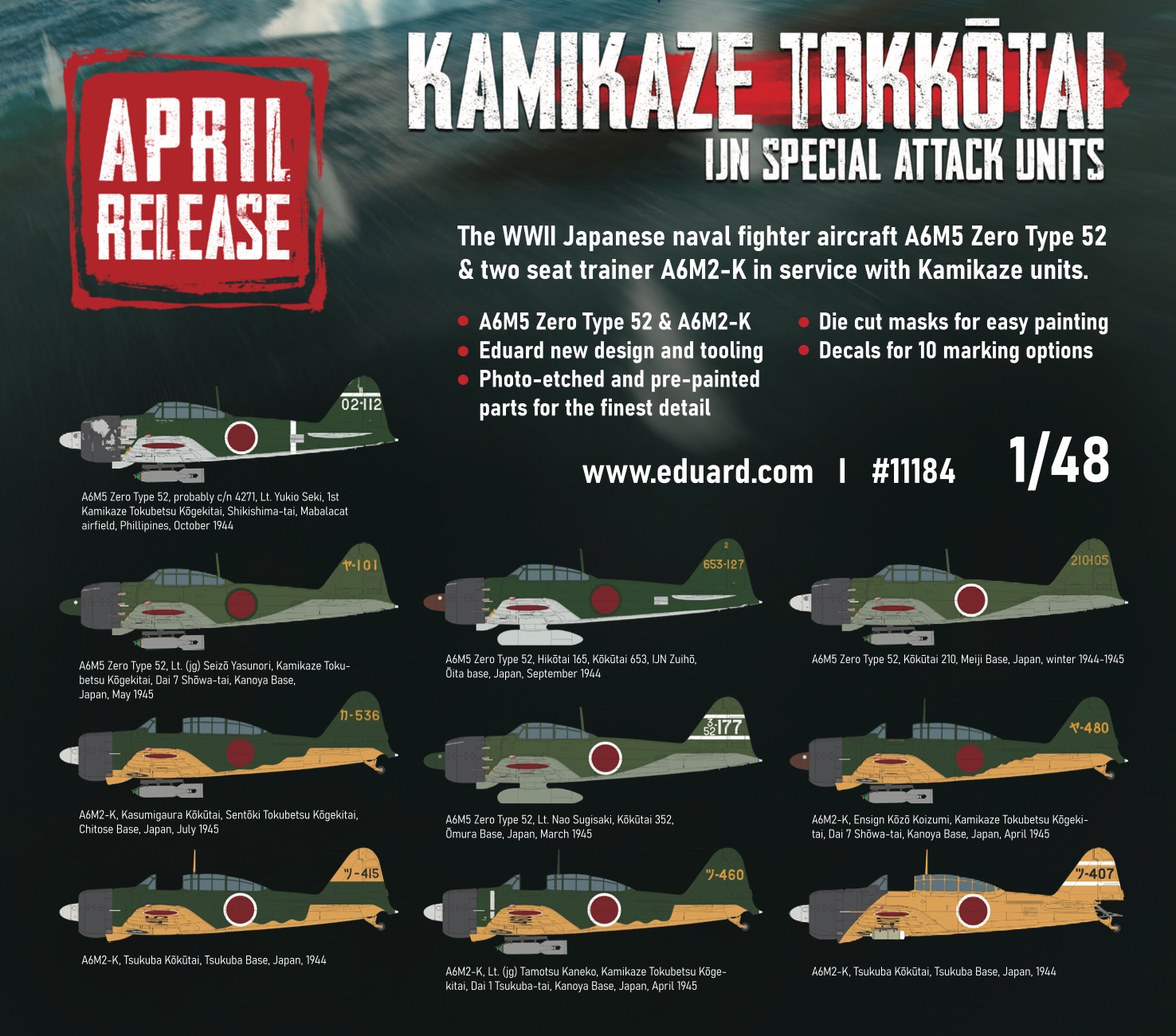

| SKU | EDK11184 |
|---|---|
| Manufacturer | Eduard |
| Scale | 1/48 |
| EAN | 8591437597079 |
| Short Description | KAMIKAZE TOKKOTAI DUAL COMBO Premiere of the new model kits: Mitsubishi A6M5 Zero Model 52 and the two-seat trainer Zero A6M2-K both in 1/48 scale! A6M5 Zero Type 52, probably c/n 4271, Lt. Yukio Seki, 1st Kamikaze Tokubetsu K?gekitai, Shikishima-tai, Mabalacat airfield, Phillipines, October 1944 A6M5 Zero Type 52, Hik?tai 165, K?k?tai 653, IJN Zuih?, ?ita base, Japan, September 1944 A6M5 Zero Type 52, K?k?tai 210, Meiji Base, Japan, winter 1944-1945 A6M5 Zero Type 52, Lt. (jg) Seiz? Yasunori, Kamikaze Tokubetsu K?gekitai, Dai 7 Sh?wa-tai, Kanoya Base, Japan, May 1945 A6M5 Zero Type 52, Lt. Nao Sugisaki, K?k?tai 352, ?mura Base, Japan, March 1945 A6M2-K, Ensign K?z? Koizumi, Kamikaze Tokubetsu K?gekitai, Dai 7 Sh?wa-tai, Kanoya Base, Japan, April 1945 A6M2-K, Kasumigaura K?k?tai, Sent?ki Tokubetsu K?gekitai, Chitose Base, Japan, July 1945 A6M2-K, Lt. (jg) Tamotsu Kaneko, Kamikaze Tokubetsu K?gekitai, Dai 1 Tsukuba-tai, Kanoya Base, Japan, April 1945 A6M2-K, Tsukuba K?k?tai, Tsukuba Base, Japan, 1944 A6M2-K, Tsukuba K?k?tai, Tsukuba Base, Japan, 1944 |
-
 Eduard 1/48 Messerschmitt Bf-109G Weekend Edition # 84201Special Price £17.64 was £19.60 Save 10%
Eduard 1/48 Messerschmitt Bf-109G Weekend Edition # 84201Special Price £17.64 was £19.60 Save 10% -
 Eduard 1/48 Supermarine Spitfire Mk.XVI High Back # 8286Special Price £26.99 was £29.99 Save 10%
Eduard 1/48 Supermarine Spitfire Mk.XVI High Back # 8286Special Price £26.99 was £29.99 Save 10% -
 Eduard 1/48 Fokker E.III Weekend Edition # 8419Special Price £15.48 was £17.20 Save 10%
Eduard 1/48 Fokker E.III Weekend Edition # 8419Special Price £15.48 was £17.20 Save 10% -
 Eduard 1/48 Grumman F4F-4 Wildcat Late ProfiPACK Edition # 82203Special Price £25.79 was £28.65 Save 10%
Eduard 1/48 Grumman F4F-4 Wildcat Late ProfiPACK Edition # 82203Special Price £25.79 was £28.65 Save 10% -
 Eduard 1/48 Supermarine Spitfire Mk.IXc Late Weekend Edition # 84199Special Price £17.64 was £19.60 Save 10%
Eduard 1/48 Supermarine Spitfire Mk.IXc Late Weekend Edition # 84199Special Price £17.64 was £19.60 Save 10% -
 Eduard 1/48 Overlord: D-Day Mustangs P-51B Mustang Dual Combo Limited Edition # 11181Special Price £48.15 was £53.50 Save 10%
Eduard 1/48 Overlord: D-Day Mustangs P-51B Mustang Dual Combo Limited Edition # 11181Special Price £48.15 was £53.50 Save 10% -
 Eduard 1/48 Supermarine Spitfire Mk.IIa Weekend Edition # 84206Special Price £18.54 was £20.60 Save 10%
Eduard 1/48 Supermarine Spitfire Mk.IIa Weekend Edition # 84206Special Price £18.54 was £20.60 Save 10% -
 Eduard 1/48 PACIFIC STAR Curtiss P-40E Warhawk DUAL COMBO Limited Edition # 11185Special Price £53.99 was £59.99 Save 10%
Eduard 1/48 PACIFIC STAR Curtiss P-40E Warhawk DUAL COMBO Limited Edition # 11185Special Price £53.99 was £59.99 Save 10% -
 Eduard 1/48 North-American P-51B Mustang with the Malcolm Hood Canopy ProfiPACK Edition # 82176Special Price £26.55 was £29.50 Save 10%
Eduard 1/48 North-American P-51B Mustang with the Malcolm Hood Canopy ProfiPACK Edition # 82176Special Price £26.55 was £29.50 Save 10% -
 Eduard 1/48 Focke-Wulf Fw-190A-3 Weekend Edition # 84205Special Price £18.54 was £20.60 Save 10%
Eduard 1/48 Focke-Wulf Fw-190A-3 Weekend Edition # 84205Special Price £18.54 was £20.60 Save 10% -
 Eduard 1/48 Curtiss P-40E Warhawk Royal Class Dual Combo # R0023Special Price £80.99 was £89.99 Save 10% Free UK Delivery
Eduard 1/48 Curtiss P-40E Warhawk Royal Class Dual Combo # R0023Special Price £80.99 was £89.99 Save 10% Free UK Delivery -
 Eduard 1/48 US Navy Aircraft Carrier Deck # 8802Special Price £7.19 was £7.99 Save 10%
Eduard 1/48 US Navy Aircraft Carrier Deck # 8802Special Price £7.19 was £7.99 Save 10% -
 Eduard 1/48 Messerschmitt Bf-109K-4 # 82166Special Price £25.83 was £28.70 Save 10%
Eduard 1/48 Messerschmitt Bf-109K-4 # 82166Special Price £25.83 was £28.70 Save 10% -
 Eduard 1/48 Grumman F4F-4 Wildcat Late # 84204Special Price £17.64 was £19.60 Save 10%
Eduard 1/48 Grumman F4F-4 Wildcat Late # 84204Special Price £17.64 was £19.60 Save 10% -
 Eduard 1/48 North-American Mustang Mk.III ProfiPACK Edition # 82109Special Price £25.83 was £28.70 Save 10%
Eduard 1/48 North-American Mustang Mk.III ProfiPACK Edition # 82109Special Price £25.83 was £28.70 Save 10% -
 Eduard 1/48 Messerschmitt Bf-109G-4 Weekend Edition # 84203Special Price £17.64 was £19.60 Save 10%
Eduard 1/48 Messerschmitt Bf-109G-4 Weekend Edition # 84203Special Price £17.64 was £19.60 Save 10% -
 Eduard 1/48 General-Motors FM-2 Wildcat ProfiPACK Edition # 82205Special Price £25.83 was £28.70 Save 10%
Eduard 1/48 General-Motors FM-2 Wildcat ProfiPACK Edition # 82205Special Price £25.83 was £28.70 Save 10% -
 Eduard 1/48 The Bloody Hundredth 1943 Boeing B-17F Flying Fortress Limited Edition # 11183Special Price £139.99 was £159.99 Save 13% Free UK Delivery
Eduard 1/48 The Bloody Hundredth 1943 Boeing B-17F Flying Fortress Limited Edition # 11183Special Price £139.99 was £159.99 Save 13% Free UK Delivery -
 Eduard 1/48 North-American P-51B Mustang Birdcage Canopy ProfiPACK Edition # 82107Special Price £25.83 was £28.70 Save 10%
Eduard 1/48 North-American P-51B Mustang Birdcage Canopy ProfiPACK Edition # 82107Special Price £25.83 was £28.70 Save 10% -
 Eduard 1/48 Supermarine Spitfire Mk.Vb OVERLORD Weekend Edition # 84200Special Price £17.64 was £19.60 Save 10%
Eduard 1/48 Supermarine Spitfire Mk.Vb OVERLORD Weekend Edition # 84200Special Price £17.64 was £19.60 Save 10% -
 Eduard 1/48 Messerschmitt Bf-109G Weekend Edition # 84201Special Price £17.64 was £19.60 Save 10%
Eduard 1/48 Messerschmitt Bf-109G Weekend Edition # 84201Special Price £17.64 was £19.60 Save 10% -
 Eduard 1/48 Supermarine Spitfire Mk.XVI High Back # 8286Special Price £26.99 was £29.99 Save 10%
Eduard 1/48 Supermarine Spitfire Mk.XVI High Back # 8286Special Price £26.99 was £29.99 Save 10% -
 Eduard 1/48 Fokker E.III Weekend Edition # 8419Special Price £15.48 was £17.20 Save 10%
Eduard 1/48 Fokker E.III Weekend Edition # 8419Special Price £15.48 was £17.20 Save 10% -
 Eduard 1/48 Grumman F4F-4 Wildcat Late ProfiPACK Edition # 82203Special Price £25.79 was £28.65 Save 10%
Eduard 1/48 Grumman F4F-4 Wildcat Late ProfiPACK Edition # 82203Special Price £25.79 was £28.65 Save 10% -
 Eduard 1/48 Supermarine Spitfire Mk.IXc Late Weekend Edition # 84199Special Price £17.64 was £19.60 Save 10%
Eduard 1/48 Supermarine Spitfire Mk.IXc Late Weekend Edition # 84199Special Price £17.64 was £19.60 Save 10% -
 Eduard 1/48 Overlord: D-Day Mustangs P-51B Mustang Dual Combo Limited Edition # 11181Special Price £48.15 was £53.50 Save 10%
Eduard 1/48 Overlord: D-Day Mustangs P-51B Mustang Dual Combo Limited Edition # 11181Special Price £48.15 was £53.50 Save 10% -
 Eduard 1/48 Supermarine Spitfire Mk.IIa Weekend Edition # 84206Special Price £18.54 was £20.60 Save 10%
Eduard 1/48 Supermarine Spitfire Mk.IIa Weekend Edition # 84206Special Price £18.54 was £20.60 Save 10% -
 Eduard 1/48 PACIFIC STAR Curtiss P-40E Warhawk DUAL COMBO Limited Edition # 11185Special Price £53.99 was £59.99 Save 10%
Eduard 1/48 PACIFIC STAR Curtiss P-40E Warhawk DUAL COMBO Limited Edition # 11185Special Price £53.99 was £59.99 Save 10% -
 Eduard 1/48 North-American P-51B Mustang with the Malcolm Hood Canopy ProfiPACK Edition # 82176Special Price £26.55 was £29.50 Save 10%
Eduard 1/48 North-American P-51B Mustang with the Malcolm Hood Canopy ProfiPACK Edition # 82176Special Price £26.55 was £29.50 Save 10% -
 Eduard 1/48 Focke-Wulf Fw-190A-3 Weekend Edition # 84205Special Price £18.54 was £20.60 Save 10%
Eduard 1/48 Focke-Wulf Fw-190A-3 Weekend Edition # 84205Special Price £18.54 was £20.60 Save 10% -
 Eduard 1/48 Curtiss P-40E Warhawk Royal Class Dual Combo # R0023Special Price £80.99 was £89.99 Save 10% Free UK Delivery
Eduard 1/48 Curtiss P-40E Warhawk Royal Class Dual Combo # R0023Special Price £80.99 was £89.99 Save 10% Free UK Delivery -
 Eduard 1/48 US Navy Aircraft Carrier Deck # 8802Special Price £7.19 was £7.99 Save 10%
Eduard 1/48 US Navy Aircraft Carrier Deck # 8802Special Price £7.19 was £7.99 Save 10% -
 Eduard 1/48 Messerschmitt Bf-109K-4 # 82166Special Price £25.83 was £28.70 Save 10%
Eduard 1/48 Messerschmitt Bf-109K-4 # 82166Special Price £25.83 was £28.70 Save 10% -
 Eduard 1/48 Grumman F4F-4 Wildcat Late # 84204Special Price £17.64 was £19.60 Save 10%
Eduard 1/48 Grumman F4F-4 Wildcat Late # 84204Special Price £17.64 was £19.60 Save 10% -
 Eduard 1/48 North-American Mustang Mk.III ProfiPACK Edition # 82109Special Price £25.83 was £28.70 Save 10%
Eduard 1/48 North-American Mustang Mk.III ProfiPACK Edition # 82109Special Price £25.83 was £28.70 Save 10% -
 Eduard 1/48 Messerschmitt Bf-109G-4 Weekend Edition # 84203Special Price £17.64 was £19.60 Save 10%
Eduard 1/48 Messerschmitt Bf-109G-4 Weekend Edition # 84203Special Price £17.64 was £19.60 Save 10% -
 Eduard 1/48 General-Motors FM-2 Wildcat ProfiPACK Edition # 82205Special Price £25.83 was £28.70 Save 10%
Eduard 1/48 General-Motors FM-2 Wildcat ProfiPACK Edition # 82205Special Price £25.83 was £28.70 Save 10% -
 Eduard 1/48 The Bloody Hundredth 1943 Boeing B-17F Flying Fortress Limited Edition # 11183Special Price £139.99 was £159.99 Save 13% Free UK Delivery
Eduard 1/48 The Bloody Hundredth 1943 Boeing B-17F Flying Fortress Limited Edition # 11183Special Price £139.99 was £159.99 Save 13% Free UK Delivery -
 Eduard 1/48 North-American P-51B Mustang Birdcage Canopy ProfiPACK Edition # 82107Special Price £25.83 was £28.70 Save 10%
Eduard 1/48 North-American P-51B Mustang Birdcage Canopy ProfiPACK Edition # 82107Special Price £25.83 was £28.70 Save 10% -
 Eduard 1/48 Supermarine Spitfire Mk.Vb OVERLORD Weekend Edition # 84200Special Price £17.64 was £19.60 Save 10%
Eduard 1/48 Supermarine Spitfire Mk.Vb OVERLORD Weekend Edition # 84200Special Price £17.64 was £19.60 Save 10% -
 Eduard 1/48 Messerschmitt Bf-109G Weekend Edition # 84201Special Price £17.64 was £19.60 Save 10%
Eduard 1/48 Messerschmitt Bf-109G Weekend Edition # 84201Special Price £17.64 was £19.60 Save 10% -
 Eduard 1/48 Supermarine Spitfire Mk.XVI High Back # 8286Special Price £26.99 was £29.99 Save 10%
Eduard 1/48 Supermarine Spitfire Mk.XVI High Back # 8286Special Price £26.99 was £29.99 Save 10% -
 Eduard 1/48 Fokker E.III Weekend Edition # 8419Special Price £15.48 was £17.20 Save 10%
Eduard 1/48 Fokker E.III Weekend Edition # 8419Special Price £15.48 was £17.20 Save 10% -
 Eduard 1/48 Grumman F4F-4 Wildcat Late ProfiPACK Edition # 82203Special Price £25.79 was £28.65 Save 10%
Eduard 1/48 Grumman F4F-4 Wildcat Late ProfiPACK Edition # 82203Special Price £25.79 was £28.65 Save 10% -
 Eduard 1/48 Supermarine Spitfire Mk.IXc Late Weekend Edition # 84199Special Price £17.64 was £19.60 Save 10%
Eduard 1/48 Supermarine Spitfire Mk.IXc Late Weekend Edition # 84199Special Price £17.64 was £19.60 Save 10% -
 Eduard 1/48 Overlord: D-Day Mustangs P-51B Mustang Dual Combo Limited Edition # 11181Special Price £48.15 was £53.50 Save 10%
Eduard 1/48 Overlord: D-Day Mustangs P-51B Mustang Dual Combo Limited Edition # 11181Special Price £48.15 was £53.50 Save 10%



